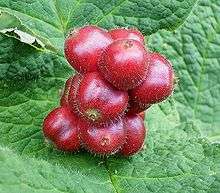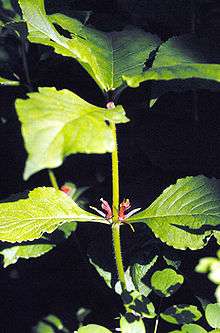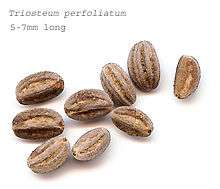Triosteum
| Triosteum | |
|---|---|
 | |
| Triosteum himalayanum fruits | |
| Scientific classification | |
| Kingdom: | Plantae |
| (unranked): | Angiosperms |
| (unranked): | Eudicots |
| (unranked): | Asterids |
| Order: | Dipsacales |
| Family: | Caprifoliaceae |
| Genus: | Triosteum L. |

Triosteum, commonly known as horse-gentian[1] or, less commonly, feverwort, is a genus of flowering plants in the Caprifoliaceae family. A genus of six species total, it has three species native to North America, and three more in eastern Asia.
Description
These are perennial, herbaceous plants of rich woods. Each plant typically consists of at least one erect, round, hairy, fistular stem, 1 to 4 feet (0.3 to 1.2m) high, with opposite ovate-lanceolate entire leaves, and whitish to purplish flowers presented either in axillary whorls or terminal racemes. The fruit is a drupe.[2] It may be white, yellow, orange, or red, depending on the species. The dried and roasted fruits have been occasionally used as a substitute for coffee; but it is chiefly valued for its medicinal properties. The roots of the American species have been used as an emetic and mild cathartic. It is sometimes called Tinker's root, after Dr. Tinker, who first brought it to notice.
Species
The species include the following:[3]
- Triosteum angustifolium - yellowfruit horse-gentian, Native to the eastern United States
- Triosteum aurantiacum - orangefruit horse-gentian, Native to the eastern United States
- Triosteum himalayanum, native to China, Bhutan, Nepal, and India[4]
- Triosteum perfoliatum - feverwort, Native to the eastern United States
- Triosteum pinnatifidum, native to China and Japan[5]
- Triosteum sinuatum, native to east Asia[6]
References
| Wikimedia Commons has media related to Triosteum. |
- ↑ "Triosteum". Natural Resources Conservation Service PLANTS Database. USDA. Retrieved 15 December 2015.
- ↑ Jacobs, B.; Lens, F.; Smets, E. (2009), "Evolution of fruit and seed characters in the Diervilla and Lonicera clades (Caprifoliaceae, Dipsacales)", Annals of Botany, 104 (2): 253–276, doi:10.1093/aob/mcp131
- ↑ Gould, K. R., Donoghue, M. J. (2000). "Phylogeny and biogeography of Triosteum (Caprifoliaceae)" (PDF). Harvard Papers in Botany. 5 (1): 157–166.
- ↑ "Triosteum himalayanum", Flora of China online
- ↑ "Triosteum pinnatifidum", Flora of China online
- ↑ "Triosteum sinuatum", Flora of China online
